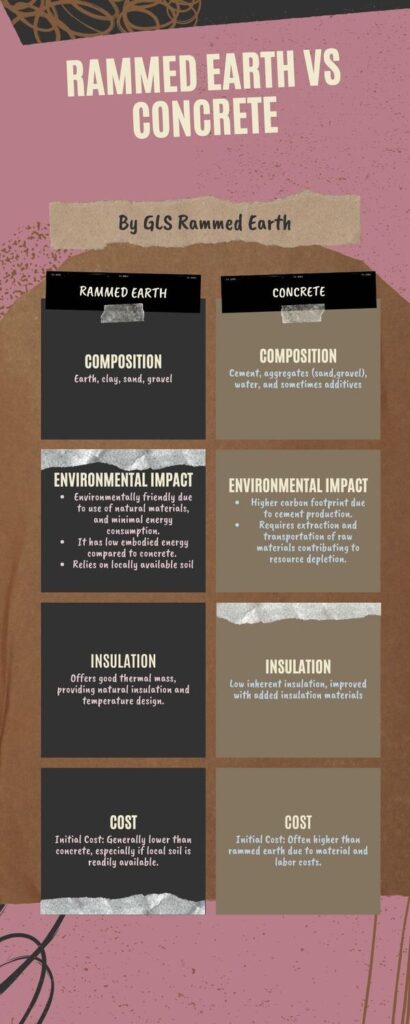In the world of construction, the debate between tradition and modernity often takes center stage. One such debate revolves around the choice between using rammed earth vs concrete as building materials. While concrete has long been the go-to material for construction, rammed earth is gaining attention for its sustainability, durability, and unique aesthetic appeal. We will explore the benefits of choosing rammed earth over concrete, address common questions about its strength and longevity, and shed light on the remarkable durability of this ancient construction technique.
As our society becomes increasingly aware of the environmental impact of construction materials, the demand for sustainable alternatives is on the rise. Rammed earth, an age-old building technique that involves compacting layers of earth within a formwork, has reemerged as an eco-friendly alternative to concrete.
1. Low Carbon Footprint: One of the standout features of rammed earth construction is its minimal carbon footprint. Concrete production is notorious for its high energy consumption and greenhouse gas emissions. Rammed earth, on the other hand, requires significantly less energy and produces minimal waste during construction.
2. Thermal Mass and Energy Efficiency: Rammed earth walls have excellent thermal mass properties. They can absorb heat during the day and release it slowly during the night, contributing to a more stable indoor temperature. This natural temperature regulation can reduce the need for heating and cooling systems, thus lowering energy consumption and utility bills.
3. Healthy Indoor Environment: Rammed earth walls are breathable and naturally regulate humidity levels. This helps to create a comfortable and healthy indoor environment, reducing the risk of mold growth and improving air quality. The absence of toxic chemicals often found in conventional construction materials also contributes to a healthier living space.
4. Unique Aesthetic Appeal: Rammed earth structures possess a distinct beauty that stems from the natural variations in color and texture of the earth used. The warm, earthy tones can evoke a sense of harmony with the surroundings, making rammed earth buildings a visual treat that stands out from the uniform appearance of concrete structures.

Is Rammed Earth Stronger Than Concrete?
The strength of construction materials is a crucial factor in determining their suitability for various applications. While concrete is renowned for its strength, rammed earth also offers impressive structural integrity.
Rammed earth walls gain strength through compression and compaction during the construction process. While concrete is known for its tensile strength, rammed earth’s compression strength can be comparable or even superior, depending on factors such as the mix design, compaction technique, and soil properties used. Rammed earth’s cohesive nature and the interlocking of particles contribute to its robustness, allowing it to withstand significant loads and pressures.
What Is the Life Expectancy of a Rammed Earth Wall?
When properly designed and constructed, rammed earth walls can last for centuries. Historical examples, such as the Great Wall of China and various ancient fortifications, stand as testaments to rammed earth’s exceptional longevity. Modern engineering practices, including proper foundation design, appropriate soil selection, and suitable maintenance, can further extend the life expectancy of rammed-earth walls.

Does Rammed Earth Need Rebar?
Reinforcement is often used in construction to enhance the structural integrity of materials like concrete. However, rammed earth’s unique properties allow it to function effectively without the need for traditional rebar.
Rammed earth’s compressive strength and cohesive nature naturally resist cracks and fractures. The interlocking particles within the rammed earth mixture provide inherent stability. While some modern rammed earth construction techniques may incorporate minimal reinforcement in specific applications, such as seismic regions, it’s not a common practice. Rammed earth’s strength primarily comes from its compacted composition and proper construction methods rather than relying on external reinforcement.
Conclusion
When it comes to building materials, the choice between rammed earth and concrete is not just a matter of aesthetics but also of sustainability and durability. Rammed earth’s eco-friendly nature, thermal efficiency, and unique aesthetic appeal make it a compelling choice for those seeking a more harmonious and sustainable living environment.
If you’re intrigued by the idea of a home that embraces the timeless beauty and sustainable qualities of rammed earth, consider exploring the offerings at GLS Rammed Earth. Our expert team specializes in creating stunning rammed earth homes that seamlessly blend innovation with tradition.

